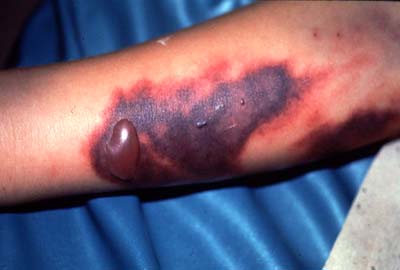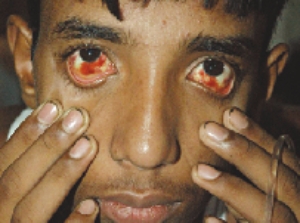Pathology and Incidence: Dengue hemorrhagic fever is characterized by a fever that lasts from 2 to 7 days, with general signs and symptoms consistent with dengue fever. When the fever declines, symptoms including persistent vomiting, severe abdominal pain, and difficulty breathing, may develop. This marks the beginning of a 24- to 48-hour period when the smallest blood vessels (capillaries) become excessively permeable (“leaky”), allowing the fluid component to escape from the blood vessels into the peritoneum (causing ascites) and pleural cavity (leading to pleural effusions). This may lead to failure of the circulatory system and shock, followed by death, if circulatory failure is not corrected. In addition, the patient with DHF has a low platelet count and hemorrhagic manifestations, tendency to bruise easily or other types of skin hemorrhages, bleeding nose or gums, and possibly internal bleeding.
Dengue virus belongs to the family Flaviviridae (genus Flavivirus) and has emerged as the most common arboviral disease in the world. The disease is endemic to tropical and subtropical areas of the world, with about 2.5 billion people (40% of the world's population) at risk of acquiring the infection. Dengue virus is transmitted to humans through the bites of infective female Aedes mosquitoes (particularly A aegypti and A albopictus). Mosquitoes generally acquire the virus while feeding on the blood of an infected person. After an incubation period of 8-10 days, an infected mosquito is capable, during probing and blood feeding, of transmitting the virus to susceptible individuals for the rest of its life. Unlike malaria, which is more prevalent in rural areas, DF is spread via mosquitoes that thrive in highly populated urban environments.
Four distinct, but closely related, viruses (termed dengue virus types 1-4 [DENV 1-4]) cause DF. Humans are the main amplifying host of the virus. Infection with 1 of the 4 serotypes of dengue virus causes a wide spectrum of clinical disease, including asymptomatic infection, undifferentiated fever, DF, and DHF. DHF occurs in a minority of patients and is characterized by bleeding and plasma leakage, which may lead to shock. The major risk factor for DHF is prior immunity to a single dengue virus serotype. Infection with one dengue serotype confers lifelong homotypic immunity and a very brief period of partial heterotypic immunity (~6 months), but an individual can eventually be infected by more than one serotype. An individual could therefore experience a case of DENV-1 fever in one year, followed by a case of DENV-2 fever in the following year. Third infections are, however, very rare, and fourth infections have never been reported.[6] Several serotypes can be in circulation during a particular epidemic.
Some people infected with DF are asymptomatic. Young children often have a fever with a rash, but other symptoms are minor. Older children and adults may also have mild symptoms; however, they are more likely to experience classic DF. Symptoms of DF include a high fever (up to 105° F [40.5° C]), severe headache, retro-orbital pain, severe muscle and joint pain, swollen lymph nodes, general malaise, nausea, and vomiting; a macular erythematous rash with petechiae may also be observed.[7] The differential diagnosis for DF and DHF is broad and includes meningococcal meningitis, septicemia and disseminated intravascular coagulation, other hemorrhagic fevers (Crimean Congo hemorrhagic fever, Ebola, etc.), thrombotic thrombocytopenic purpura, falciparum malaria, leptospirosis, aplastic anemia, acute leukemia, and yellow fever.

Direct person-to-person transmission of dengue virus has not been documented. A few case reports have been published of transmission of DENV through exposure to dengue-infected blood, organs, or other tissues from blood transfusions; solid organ or bone marrow transplants; needle stick injuries; and mucous membrane contact with dengue-infected blood.
Dengue is transmitted between people by the mosquitoes Aedes aegypti and Aedes albopictus, which are found throughout the world. Insects that transmit disease are vectors. Symptoms of infection usually begin 4 - 7 days after the mosquito bite and typically last 3 - 10 days. In order for transmission to occur the mosquito must feed on a person during a 5- day period when large amounts of virus are in the blood; this period usually begins a little before the person become symptomatic. Some people never have significant symptoms but can still infect mosquitoes. After entering the mosquito in the blood meal, the virus will require an additional 8-12 days incubation before it can then be transmitted to another human. The mosquito remains infected for the remainder of its life, which might be days or a few weeks.
Outbreaks of dengue occur primarily in areas where Ae. aegypti (sometimes also Ae. albopictus) mosquitoes live. This includes most tropical urban areas of the world. Dengue viruses may be introduced into areas by travelers who become infected while visiting other areas of the tropics where dengue commonly exists.

In rare cases dengue can be transmitted inorgan transplants or blood transfusions from infected donors, and there is evidence of transmission from an infected pregnant mother to her fetus. But in the vast majority of infections, a mosquito bite is responsible.
